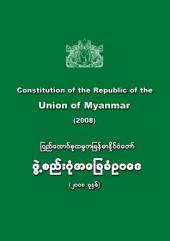
Chapter II
State Structure
- The Union is delineated and constituted by seven Regions, seven States and the Union territories as follows :
(a) Kachin State;
(b) Kayah State;
(c) Kayin State;
(d) Chin State;
(e) Sagaing Region;
(f) Taninthayi Region;
(g) Bago Region;
(h) Magway Region;
(i) Mandalay Region;
(j) Mon State;
(k) Rakhine State;
(l) Yangon Region;
(m) Shan State;
(n) Ayeyawady Region; and (o) Union territories.
- (a) Nay Pyi Taw, the capital of the Union, prescribed as Union territory, shall be under the direct administration of the President.
(b) If there arises a need to specify areas that have special situations concerning national defence, security, administration and economy, so forth, those areas may be prescribed as Union territories under the direct administration of the President after enacting law.
- The Union is constituted as follows :
(a) villages are organized as village-tract;
(b) wards are organized as town or township;
(c) village-tracts and wards or towns are organized as township;
(d) townships are organized as district;
(e) districts are organized as Region or State;
(f) townships in a Self-Administered Zone are organized as Self-Administered Zone;
(g) townships in a Self-Administered Division are organized as District and such Districts are organized as Self-Administered Division;
(h) If there are Self-Administrated Zone or Self-Administered Division in a Region or a State, those Self-Administered Divisions, Self-Administered Zones and Districts are organized as Region or State;
(i) Regions, States and Union territories are organized as the Republic. - (a) If there arises a need to re-delineate the territorial boundary of the Union, the President shall firstly intimate the Head of the Pyidaungsu Hluttaw to ask for the opinion of the Pyidaungsu Hluttaw.
(b) The Head of the Pyidaungsu Htuttaw, after receiving the intimation of the President, shall obtain the opinion of the Hluttaw representatives as follows : -
- assenting votes of more than half of the total number of representatives in the Hluttaw, elected in equal numbers from Regions and States;
- assenting votes of more than half of the total number of representatives in the Hluttaw, elected as representatives on the basis of township as well as population;
- assenting votes of more than half of the total number of representatives of the two Hluttaws from the Region or State involved in the boundary concerned.
(c) The Head of the Pyidaungsu Hluttaw, after obtaining the assenting votes as mentioned above, shall inform the President for re-delineating the territorial boundary of the Union as necessary.
(d) In accord with the above-mentioned procedures, if either of the Hluttaws, or representatives from the Region or State involved in the territorial boundary concerned resolve against re-delineation, the opinion of the Pyidaungsu Hluttaw shall be obtained. If three-fourths and above of the total number of the Pyidaungsu Hluttaw representatives cast assenting votes, the Head of the Pyidaungsu Hluttaw shall inform the President to re-delineate the territorial boundary as necessary.
(e) The President shall take necessary measures for re-delineation of the territorial boundary of the Union, as necessary, after obtaining the opinion of the Pyidaungsu Hluttaw.
- (a) If there arises a cause to re-delineate the territorial boundary of a Region or a State, the prior consent of the electorate residing within the township concerned shall be obtained.
(b) In obtaining consent, re-delineation of the territorial boundary shall not be executed at all in the absence of assenting votes of more than half of the total number of the electorate residing within the township concerned.
(c) If more than half of the total number of eligible voters residing within the township concerned cast assenting vote for re-delineation of the territorial boundary, the consent of the Hluttaw representatives of the Region or State involved in the territorial boundary concerned shall be obtained.
(d) The President shall re-delineate the territorial boundary of the Region or State concerned with the consent of the Pyidaungsu Hluttaw, after obtaining the assenting votes of three-fourths and above of the total number of representatives from the Region or the State concerned.
(e) The resolution of the Pyidaungsu Hluttaw shall be obtained if a Region Hluttaw or a State Hluttaw concerned decided against re-delineation of the territorial boundary.
(f) The President shall, as necessary, re-delineate the territorial boundary of a Region or a State if three-fourths and above of the total number of representatives in the Pyidaungsu Hluttaw assent to the re-delineation of the territorial boundary. - Where there arises a situation to alter or form the territorial boundary or change the name of a village, village-tract, ward, town, township or district of a Region, State, Self-Administered Division or Self-Administered Zone concerned, the President shall act, as necessary, upon the recommendation of the Chief Minister of the Region or State concerned.
- If it is desired to change the name of a Self-Administered Division or SelfAdministered Zone, the same procedure shall be applied as in the case of changing the name of a Region or State.
- The Self-Administered Divisions and Self-Administered Zones are delineated as follows :
(a) grouping Leshi, Lahe and Namyun townships in Sagaing Division as Naga Self-Administered Zone;
(b) grouping Ywangan and Pindaya townships in Shan State as Danu SelfAdministered Zone;
(c) grouping HoPong, HsiHseng and Pinlaung townships in Shan State as Pa-O Self-Administered Zone;
(d) grouping Namhsan and Manton townships in Shan State as Pa Laung SelfAdministered Zone;
(e) grouping Konkyan and Laukkai townships in Shan State as Kokang Self-Administered Zone;
(f) grouping six townships – Hopang, Mongma, Panwai, Nahpan, Metman and Pangsang (Pankham) townships in Shan State as two districts which are forged into ‘Wa’ Self-Administered Division.
